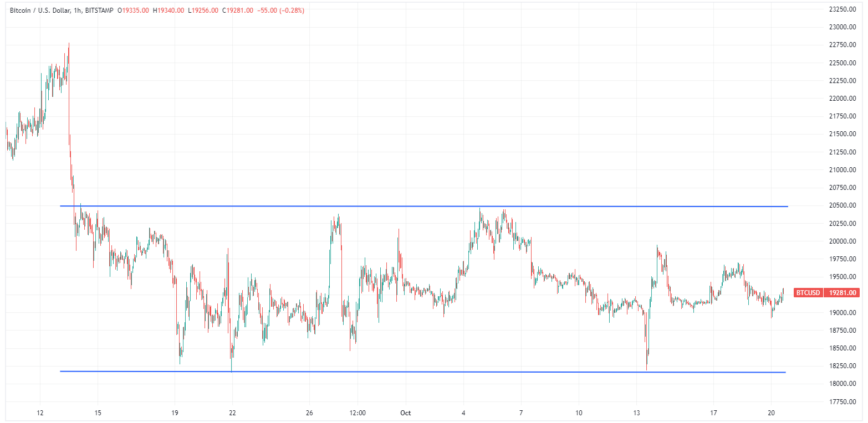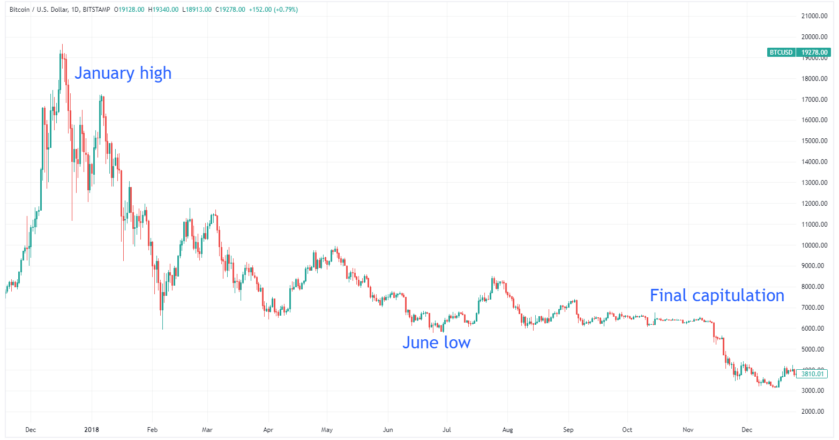Key learning points
- After a month of narrow trading ranges, some commentators are wondering if the bottom has been reached.
- However, looking at recent price action doesn’t tell the whole story.
- Comparing the relative trading volumes between the 2018 recording and today gives a more complete picture.
share this article
An unreactive crypto market can be a signal that prices have found a bottom.
Crypto volatility is falling
After months of downward volatility, the crypto market seems to be stagnating.
Over the past month, the prices of many major crypto-assets have remained trapped in an ever-narrowing range. Since Sept. 15, Bitcoin has been fluctuating within a tight $2,350 range that appears to be shrinking over time. Ethereum, the second largest cryptocurrency, has shown a similar decline in volatility, bouncing between the $1,400 and $1,200 levels over the past month.

According to the Crypto Volatility Index (CVI), price movements are the most subdued since May 7, shortly before the Terra blockchain’s UST stablecoin lost its dollar peg and went into a death spiral, sending shock waves across the market. The CVI currently stands at 65.99, not far from an all-time low of 50.41, which was set on March 31, 2019.
The effect is so pronounced that Bitcoin has become less volatile than some traditional stock indices. For example, over the past month, Bitcoin has traded within a 9.4% range, as opposed to a 10.35% range for the NASDAQ100. In addition, stock volatility, as measured by the S&P Volatility Index, recently registered a new all time high against Bitmex’s Bitcoin Historical Volatility Index, highlighting the magnitude of the drop in volatility of major crypto assets.
There are several reasons why crypto volatility has dropped. The most prominent factor is the lack of trading volume in the crypto markets. According to facts from Blockchain.com, total USD trading volume on major Bitcoin exchanges has hit a 30-day average low of $143.5 million, the lowest level since November 2020. When there is less buying and selling of Bitcoin, it often results in lower price movements.
However, broader macroeconomic factors are also likely to play a role in Bitcoin’s relative price stability. Uncertainty in global markets continued to weigh on traditional stocks. The Federal Reserve’s monetary tightening policy, aimed at curbing inflation, has left many market participants concerned about the potential long-term damage to the financial system. US Treasury yields have surged in recent weeks, indicating a lack of confidence in the government’s ability to pay off its debts.
Since Bitcoin and other cryptocurrencies are not directly connected to the traditional financial system, they may have escaped some of the problems faced by other financial assets such as stocks and bonds. Furthermore, as the crypto crash in June forced many major holders to exit the market, those who still own crypto are unlikely to be inclined to sell anytime soon. While these factors explain the lack of sellers, they can also affect potential buyers. The gloomy macroeconomic outlook means those willing to buy back their holdings will wait patiently for a sign that the worst is over.
Has Bitcoin bottomed out?
The recent lack of volatility has led many to wonder if Bitcoin has found a bottom around its current price.
One way to judge whether Bitcoin has bottomed is to compare the current state of the market to that of the crypto winter of 2018. In 2018, Bitcoin’s price fell sharply during the first half of the year, from a high of $17,176 on January 5 to a low of $5,768 on June 24. up, but unable to drop below the June low. However, when the low was eventually challenged and broken in mid-November, it resulted in a capitulation event that took the top crypto to the cycle low of $3,161.

A surprisingly similar situation is currently playing out in 2022. Bitcoin hit a local low of $17,636 on June 18 and has failed to go below that despite several attempts. All else aside, a direct price comparison between the 2018 bear market and the current one would suggest that, as in 2018, there is one last step to take.
However, just comparing price action doesn’t tell the whole story. Taking into account the relative trading volumes between the 2018 recording and today gives a more complete picture. Compared to 2018, Bitcoin trading volumes on major exchanges are already much lower than at the same point in 2018. It may be that the forced sale due to the collapse of the Terra ecosystem and the bankruptcy of Three Arrows Capital in June capitulation and helped the market bottom out faster than in 2018.
As I mentioned in an earlier article on a potential market bottom, several technical indicators that were absent at a similar point in the 2018 bear market also have flashing signals. Net unrealized gain/loss (NUPL), the Pi Cycle Bottomand the Pull Multiple all have already reached once-in-a-cycle levels that have historically marked a bottom. It is worth noting that these figures have so far proved accurate for the current cycle as the market has failed to break the June low. It is possible that the longer the market stays above the June low, the more confident investors will be that the bottom has been reached. This could encourage buyers and result in a partial market recovery similar to what happened in 2019.
But for this scenario to have any chance of success, Bitcoin would need to stay strong throughout November. While bulls will argue there is a chance of a rally ahead of the US midterm elections, bears still seem to be in control due to high inflation and a poor global macroeconomic outlook. All in all, not much has changed since we last looked at the possibility of a market bottom in July. But judging by the current lack of volatility, I expect we’ll find out sooner rather than later whether or not a definitive drop is in store for the current crypto winter.
Disclosure: At the time of writing this piece, the author owned ETH, BTC, and several other cryptocurrencies.

